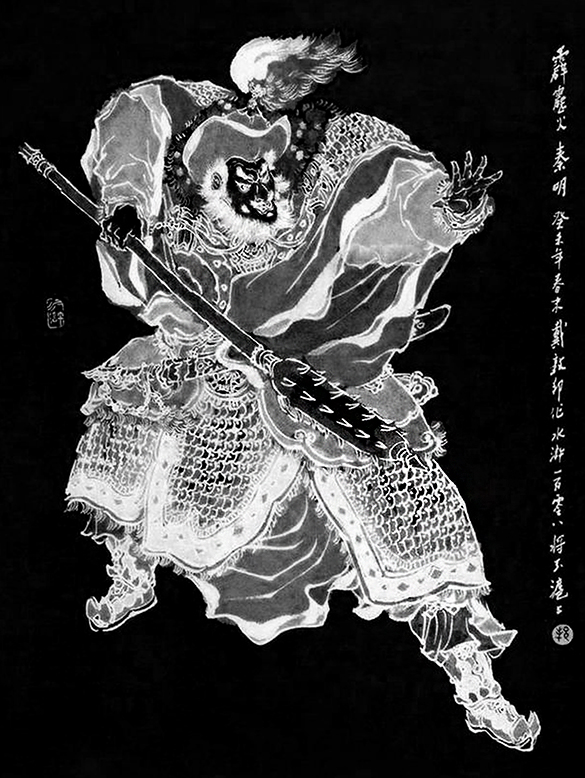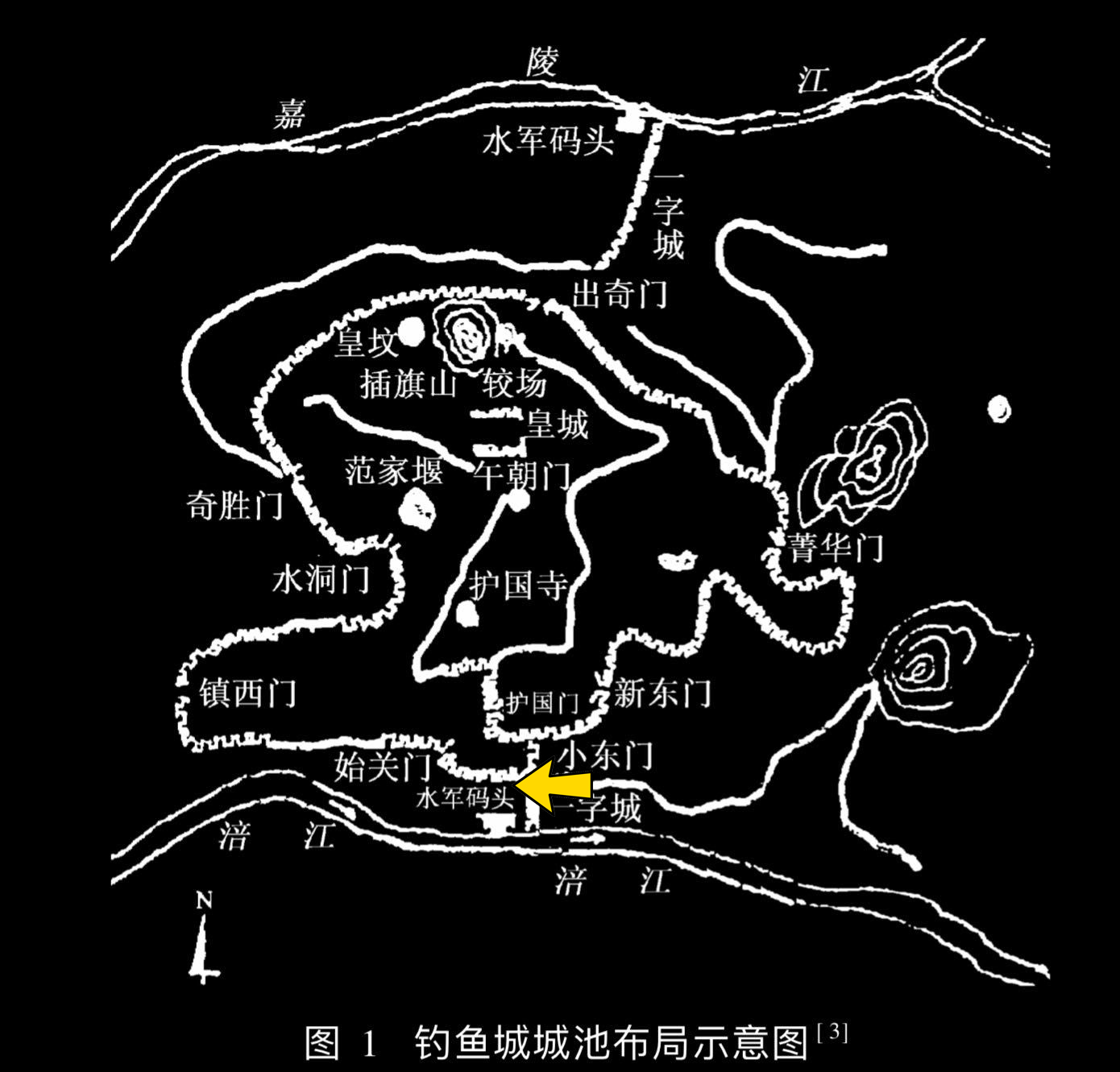Song Dynasty Infantry (Veteran): 宋代老兵司
.jpg)
Music: Northern Grasslands
Maker: KongLingGe Toys: 1/6 Size Song Dynasty Soldier Model
A grizzled Song Dynasty veteran dressed for long campaign. He wears a wide brimmed felt hat called Fànyáng lì 范阳笠- distinguished by its domed top and plume. It is secured around the neck with a strap. The Fanyang li were frequently wore by soldiers on campaigns from foot soldiers to meritorious officers.

Example on a general:
WOLF TOOTH STAFF
He is equipped with a variety of weapons
▷ A Wolf Tooth Staff 狼牙棍- spiked spear. Although heavier versions of this weapon exist called Wolf Tooth Club 狼牙棒, which has a much heavier head resembles an oversized 2 handed spiked club.
Langya Bang 狼牙棒: Wolf Tooth Club- an intimidating looking weapon. A heavily spiked metal club with a long handle- and a flanged blade at the end. This weapon is very iconic and was seen worn by legendary commander such as Qin Ming in the Chinese classic novel "The Water Margin" / "Outlaws of the Marsh"
The staffed version are longer and somewhat evergreen. As recent as 2020 the weapon was wielded by border troops against their Indian counterparts during clashes along the LAC.
HORSE CHOPPER

▷ He also wields a 2 handed horse chopper- One of the ad hoc ways the Song countered the Jurchen and Khitan deployment of massed heavily armored cavalry was the deployment of massive 2 handed horse choppers for its foot soldiers. Often once the initial charge were resisted by the front row of pikemen these men would wade to the front and hack at the engaged enemy cavalry.
▷ A 1 Handed Hacking Sword with Ring Pommel- a very simple and utilitarian design but could be mass produced in large numbers. Other equipment which the veteran carries included a drinking gourd used as a canteen, straw sandals, and a small tool pouch.
SOUTHERN SONG RIVERINE MARINES
Song dynasty incendiary bomb arrow from Wujing Zongyao (lit. "Complete Essentials for the Military Classics".)
After the loss of the north in 1127, the Song established a standing naval force to guard the region between the Huai River and the Changjiang. The Imperial Commissioner for the Control and Organization of the Coastal Areas was established in 1132 with 11 squadrons and 3,000 men under its command. The Southern Song fleet capacity increased to 15 squadrons and 21,000 men by 1174, and 20 squadrons and 52,000 men by 1237. In 1167, another base was established at Xupu to guard the Changjiang and the village that would become Shanghai.
Medieval Chinese Stealth Transport Paddleboats: the Qianli chuan 千里船 (lit. "Thousand League Boat") were paddle wheel boats used in medieval China. The boats were driven by human pedaling and were able to cruise hundreds of kilometers per day with no wind blowing. Because they had no sails their silhouette profile was extremely low in water and some historians believed they were employed as inconspicuous transports able to both stealthily deploy advance parties behind enemy lines and also extract soldiers from hotly contested frontlines.
One of the primary factors of enduring Southern Song resilience as a state was its powerful riverine paddle boat fleet. Able to sail for many hundreds of kilometers a day without any wind and able to drop soldiers anywhere along the shores proved a great force multiplier against northern invaders such as the Jin and later Mongol (Yuan) armies. The largest of them were designed into fortress ships with archers hidden inside from crossbow slits and were equipped with bombs and rockets.
Reconstruction based on Qing dynasty manuals of its hypothetical construction- Late-8th-century AD records have descriptions of the qanli chuan as a type of naval boat that had two wheels found on its sides that was propelled by treadmills.
Qianli chuan were invented in the late 5th century AD during the Southern Qi dynasty, and the invention is attributed to the ancient Chinese astronomer and mathematician Zu Chongzhi. References made to the boat were made recalling various tests on the Xinting River, south of modern Nanjing. The boat was proven to be able to cruise several hundred kilometers in a single day without any wind blowing.
Music: Battlefield (Zide Guqin Studio)
THE TENACIOUS SOUTHERN SONG FORTRESSES
A dragon of green mountain stone: The Diaoyu Fortress 钓鱼城 (lit. "Fisherman's Fortress") was a vital fortress that sat at a critical junction of 3 rivers: the Qu, Fu and Jialing rivers. The control of the fortress allowed the Song to check any ship and troop movements in the region thereby preventing the Mongol armies from penetrating deeper southwards. Extensively fortified on a precarious hill overlooking a fish-hooked bent in the river (fisherman's hook) it consisted of multiple levels of ring walls and fortified gate houses over narrow climbs. A commander's fort and banner hill sat on the top. Because of its vital location in 1259 the Mongol Great Khan Möngke tried to take it with a large army of 100,000.
Much of the fighting conducted after the loss of the old Song imperial heartland (and the flight of the imperial court to the south) was contested along the vast rivers of the Yangtze and the dense amount of precarious mountain forts on the Southern Song's mountain chocked gorges in the west.
Chinese 3 Bow Ballista or San Gong Chuang Nu 三弓床弩, meaning 3 Bowed (or 3 Prod) Ballista. These are extremely powerful ballistas and takes a large team to operate and fire. During the later Song dynasty the most powerful of these requires more than 100 people to wind up the strings. However the bolts they carried packs a deadly flight and was reported to be above to fly 700 paces or even 1000 paces away. In the Song Dynasty, one step was 1.536 meters, and a thousand steps were 1536 meters. This was one of the highest range achieved by ancient long-range weapons before the advent of cannons.
In a sense these garrison troops were some of the most steadfast Song veterans. For over 36 years multiple Khans tried to take the key fort at Diaoyu Fortress, the Great Khan Möngke's siege of Diaoyu Fortress was one of the most fraught attempt to take the fortress but despite outnumbering the defenders by 2 or 3 times, it failed and the Möngke died of cholera during the siege (alternatively other sources claimed he died due to shrapnel.)
These strings of forts were so difficult to crack through and held on for so many decades that later Mongol conquerors like Kublai had to veer into the Dali kingdom and Vietnam to outflank the Song entrenchments. After this the Mongol army was able to crush the Song imperial fleet at Yamen. In the climax of that blazing inferno at sea the Song royal court- including the young emperor committed suicide by throwing themselves into the sea.
The fortress (by then long starved and isolated) only surrendered when the Southern Song was completely destroyed and the Yuan offered favorable terms.
Thank you to my Patrons who has contributed $10 and above: You made this happen!
➢ ☯ MK Celahir
➢ ☯ Muramasa
➢ ☯ Thomas Vieira
➢ ☯ Vincent Ho (FerrumFlos1st)
➢ ☯ BurenErdene Altankhuyag
➢ ☯ Stephen D Rynerson
➢ ☯ Michael Lam
➢ ☯ Peter Hellman
➢ ☯ SunB
.jpg)
.jpg)



.jpg)


.jpg)












.jpg)







.jpg)


.jpg)
.jpg)
.jpg)


.jpg)



Comments